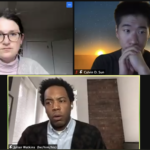Reina Maruyama speaks at STEM and Social Inclusion Event
Reina Maruyama, an Asian American female physicist at Yale, presented to STEM students about her journey from Japan to Columbia, Yale and the South Pole.

Anjali Mangla, Contributing Photographer
Reina Maruyama, associate professor of physics and astronomy, spoke at the third event of the STEM and Social Inclusion lecture series on Tuesday.
Organized by Jacqueline Tanaka, associate director of STEM student success, the series aims to expose students from underrepresented backgrounds to faculty mentors in STEM with similar backgrounds. Students involved in STEM research are invited to host each event, and are also able to ask the professor questions after their presentation. During Tuesday’s talk, Maruyama talked about her life from birth in Japan to getting her bachelor’s degree in Applied Physics from Columbia University and her doctorate from the University of Washington. She also spoke about her role now as a physics professor at Yale, where she oversees three projects in the South Pole, Italy and South Korea.
“As I was studying physics I wasn’t really thinking about being underrepresented,” Maruyama said. “When I went to Columbia as an undergraduate student, I was so excited to be surrounded by many Asian American students. I was really excited to study and I was excited to be myself, and to do something with my life. As an undergrad, I actually was the only woman in the physics major and in some of the courses I was taking.”
Maruyama found that when she moved to the West Coast to pursue her graduate studies, she found a larger Asian American community that she could resonate with as compared to her undergraduate years. During this part of her life, she said, she found that her Asian American identity superseded her identity as a woman in STEM.
Maruyama moved from Japan to the United States at the age of 12, which in turn made the transition to a predominantly white town like New Canaan, Connecticut, all the more challenging.
“The school was virtually all white, the whole town,” Maruyama said. “There were a few students of color, a few East Asian families, and so I was friends with many of them. It was tough going to middle school and high school at that time. I actually didn’t speak any English, so there were a lot of things coming together at that time that made that time pretty difficult. It was a process for me to be aware of going from being an Asian to becoming an Asian American.”
Maruyama praised the recruitment of scientists to the Yale Physics Department in the talk. In such a male-dominated field like physics, Maruyama said she appreciates Yale’s commitment to the inclusion of more female physicists within the department, in comparison to other elite universities.
Maruyama attributed this conscious recruitment within the Physics Department to professor of physics and astronomy Meg Urry, who was the former chair of the Physics Department from 2007 to 2013. Urry reached out to Maruyama and offered her a position at Yale in 2013.
“The fact that Meg Urry was the chair and she was very much invested in diversity and inclusion in the Department and in the University and in the field of physics overall, all those things were definitely a part of my decision to come to Yale,” Maruyama said.
Tanaka said she found Maruyama’s journey to be very fascinating, after the talk. One thing she noticed in her presentation was that in all of Maruyama’s photos, Maruyama was constantly surrounded by her friends and a strong support system.
According to Tanaka, keeping friends close and having a support network when studying a difficult discipline like physics is important.
“She is a person who really has a tremendous number of friends and colleagues,” Tanaka said. “The smallest research team of hers is 25, and the largest one is hundreds of people. So, at the end, we said that one of the lessons we could draw from her talk was that you need to hug your friends and listen to your friends and keep them close. That’s how you get through tough times.”
Charnice Hoegnifioh ’24, a student who attended the event, has gone to previous events during the STEM and Social Inclusion series. She said that she learned a lot about Maruyama’s field and also felt empowered as a woman of color starting out in the STEM field.
Hoegnifioh said she plans on attending future talks, as the professional mentors provide a way for students to learn how to overcome challenges within the field.
“The event with Dr. Maruyama was wonderful,” Hoegnifioh said. “As a female, person of color and first-year student researcher, it was incredible to hear about Dr. Maruyama’s journey in astrophysics. I came away from her talk with not only a deeper understanding of astrophysics, dark matter and neutrinos, but also with much-needed knowledge on how to overcome challenges and persevere in STEM fields.”
Maruyama is currently leading three international projects that are a part of the search for the basis of dark matter: COSINE-100 in South Korea, DM-Ice at the South Pole and CUORE, located in Italy. She is also involved in the HAYSTAC collaboration at Yale — which is exploring the possibility that dark matter is composed of particles called axions.
With the Atlanta spa shootings occurring a week before the event, Tanaka opened the talk by honoring the women who had been killed by reading the list of names of the Asian women who were killed.
Tanaka thought it was important to acknowledge ongoing social injustice while opening a talk about STEM and Social Inclusion, as Maruyama’s own Asian heritage was so important to her journey. Tanaka’s daughter is also Japanese American, which was another motivating factor for her to address the recent racial trauma.
“It’s not just the social identity in STEM, it really is about being an Asian American woman in STEM, on a week where, a week after, horrific things happened to Asian women,” Tanaka said. “I felt it was really important to say the names of the women who had died.”
The next STEM and Social Inclusion speaker is Larry Gladney, the Phyllis A. Wallace dean of diversity and faculty development and professor of physics, who will give a talk on April 6.
Anjali Mangla | anjali.mangla@yale.edu
Correction, March 29: A previous version of this article incorrectly stated that Maruyama is an assistant professor of physics and astronomy — she is an associate professor of physics and astronomy. The story has been updated.









